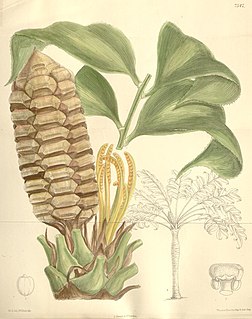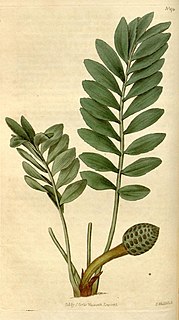
Zamia pumila, commonly known as guáyara in Spanish, is a small, tough, woody cycad native to the Greater Antilles. Z. pumila was the first species described for the genus and, therefore, is the type species for the genus Zamia and the family Zamiaceae.

Zamia is a genus of cycad of the family Zamiaceae, native to North America from the United States throughout the West Indies, Central America, and South America as far south as Bolivia.
Dypsis nossibensis is a species of flowering plant in the family Arecaceae. It is found only in the Lokobe Forest in north-west Madagascar and is threatened by habitat loss. Fewer than 25 trees have been counted.
Naufraga balearica is an extremely rare species of flowering plant in the family Apiaceae, and the only species in the monotypic genus Naufraga. It is endemic to the Spanish island of Majorca, where it is found only at the base of cliffs at the north of the island near Pollença. A population was discovered on Corsica in 1981, but it had died out by 1983, and it is not clear whether it arrived naturally. Its natural habitats are Mediterranean-type shrubby vegetation and rocky shores.
Euphorbia quitensis is a species of plant in the family Euphorbiaceae. It is endemic to Ecuador. Its natural habitat is subtropical or tropical moist montane forests.
Neocheiropteris palmatopedata is a species of fern in the family Polypodiaceae. It is endemic to China. Its natural habitats are subtropical or tropical dry forests and subtropical or tropical moist lowland forests. It is threatened by habitat loss.
Pitcairnia devansayana is a species of flowering plant in the family Bromeliaceae. It is endemic to Ecuador. Its natural habitat is subtropical or tropical moist montane forests. It is threatened by habitat loss.
Zamia disodon is a species of plant in the family Zamiaceae. It is found in Colombia and Peru. It is threatened by habitat loss.
Zamia lacandona is a species of plant in the family Zamiaceae. It is endemic to Mexico, where it occurs only in the state of Chiapas, near Palenque and Agua Azul.
Zamia macrochiera is a species of plant in the family Zamiaceae. It is endemic to Peru. It is found near the towns of Pebas and Pucaurquillo in Maynas Province, Loreto Region; plants are found near the Rio Amiyacu and Rio Napo. It is threatened by habitat loss, and is considered critically endangered by the IUCN.

Zamia obliqua is a species of plant in the family Zamiaceae. It is found in Colombia and Panama. Its natural habitat is subtropical or tropical moist lowland forests. It is threatened by habitat loss.
Zamia prasina is a species of plant in the family Zamiaceae. It is endemic to Belize, where it occurs in the Columbia River Forest Reserve. Its natural habitat is subtropical or tropical moist montane forests. It is threatened by habitat loss.

Zamia pseudoparasitica is a species of plant in the family Zamiaceae. It is endemic to Panama. Its natural habitat is subtropical or tropical moist lowland forests on the Atlantic side of the isthmus. It is threatened by habitat loss.

Zamia pygmaea is a species of plant in the family Zamiaceae found only in Cuba. It is the smallest living cycad. It is listed as critically endangered on the IUCN Red List based on its limited distribution, severely fragmented habitat, and population of less than 250 mature individuals.

Zamia wallisii is a species of plant in the family Zamiaceae. It is endemic to Colombia. Its common name is chigua.
Amphibolis antarctica is a species of flowering plant in the family Cymodoceaceae. It is referred to by the common names wire weed or sea nymph, and is a seagrass found in coastal waters of southern and western Australia.
Madhuca montana is a tree in the family Sapotaceae. The specific epithet montana means "of the mountains", referring to its habitat.

Isoetes riparia, the shore quillwort, is a species of plant in the family Isoetaceae. It can be found in rivers, creeks, and tidal mud flats in southern Quebec and southeastern Ontario, south to eastern New York. It has 5 to 35 long, erect bright green to yellow-green leaves, which are 6 to 35 centimeters long. The velum covers one fourth of the sporangium, which can be 7 millimeters long and 4 millimeters wide. The elongated ligule can grow to be 3 millimeters long. The spherical megaspores are 430 to 680 micrometers in diameter with closely set ridges. The kidney-shaped microspores are 24-35 micrometers long, and usually have spine-tipped tubercules. The megaspores can sometimes come to resemble that of either I. echinospora, if the megaspores become eroded and bear projections that could resemble spines, or I. macrospora, if the broken ridges take a certain shape.

Isoetes tuckermanii, or Tuckerman's quillwort, is a tetraploid species of plant in the family Isoetaceae. It can be found in shallow water in Newfoundland, Nova Scotia, New Brunswick, and south through the New England states to Maryland. It bears 10 to 45 long bright green to yellow green leaves that are 4 to 25 centimeters long, usually erect, but sometimes recurved. The velum covers one fourth or less of the sporangium, which is usually unspotted, 5 millimeters long, and 3 millimeters wide. The white spherical megaspores are 400 to 650 micrometers in diameter, and bear rough-crested ridges that form a hexagonal honeycomb shape. The kidney shaped microspores are 24 to 33 micrometers long, bearing tubercles. It is very similar to I. macrospora, only reliably distinguishable by cytology or through careful megaspore measurement.

Zamia integrifolia, also known as coontie palm is a small, tough, woody cycad native to the southeastern United States, the Bahamas, Cuba, the Cayman Islands, and Puerto Rico.









